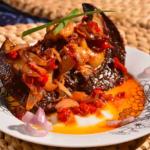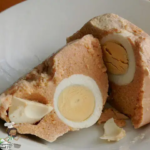In the vibrant culinary tapestry of South Sudan, Kisra holds a special place as a traditional fermented sorghum flatbread. This beloved staple showcases the rich flavors and cultural heritage of the region. Kisra, with its unique texture and tangy taste, is not only a source of sustenance but also a symbol of community and togetherness. In this article, we will delve into the world of South Sudanese Kisra, exploring its preparation, flavors, and the significance it holds in the local cuisine.
A Staple of South Sudanese Cuisine: Kisra has been a staple food in South Sudan for generations, enjoyed by both rural and urban populations. It is made from sorghum, a drought-resistant grain that is abundant in the region and forms the backbone of the local diet. Kisra provides sustenance and nourishment to communities, offering a versatile base for various meals.
The Fermentation Process: The distinct tangy flavor and unique texture of Kisra are attributed to the fermentation process. The sorghum flour is mixed with water and left to ferment for a period of time, allowing natural bacteria and yeast to break down the carbohydrates in the grain. This fermentation process not only enhances the flavor but also increases the nutritional value of Kisra, making it more easily digestible and enriching it with probiotics.
Preparation and Cooking: To make Kisra, the fermented sorghum batter is poured onto a large flat griddle or pan. The batter spreads into a thin circular shape, resembling a pancake or a crepe. It is then cooked over low heat until the surface forms a golden-brown crust while maintaining a soft and pliable texture. Kisra is typically served in large rounds or cut into smaller pieces for sharing.
Flavor Profile and Accompaniments: Kisra boasts a unique taste that combines tanginess with a subtle earthiness from the sorghum. The fermentation process adds a pleasant acidity, providing a delightful contrast to the nutty flavor of the grain. The bread itself is mild in taste, allowing it to be paired with a variety of dishes.
Kisra is often enjoyed with savory accompaniments such as stews, curries, or grilled meats. It serves as a versatile vehicle for scooping up flavorsome sauces and gravies, adding a wholesome element to the meal. Additionally, Kisra can be paired with condiments like chutneys, pickles, or spicy sambals to further elevate the taste experience.
Cultural Significance: Kisra holds cultural significance beyond its role as a staple food. It is a symbol of unity and communal sharing, often prepared and enjoyed during festive occasions and gatherings. Kisra-making ceremonies bring families and communities together, strengthening bonds and preserving cultural heritage.
Furthermore, Kisra represents the resourcefulness and resilience of the South Sudanese people. Sorghum, the main ingredient in Kisra, thrives in the arid climate of the region, making it a vital crop for sustenance. Kisra’s simplicity and nutritional value showcase the resourceful use of locally available ingredients to create a nourishing and delicious food.
South Sudanese Kisra stands as a testament to the culinary traditions and flavors of the region. This fermented sorghum flatbread captivates the taste buds with its tangy and earthy profile, while its versatility allows it to be paired with a range of dishes. Beyond its culinary attributes, Kisra carries cultural significance, fostering community and celebrating the resourcefulness of the South Sudanese people. So, if you have the opportunity to taste Kisra, savor the unique flavors and embrace the cultural heritage it embodies.








